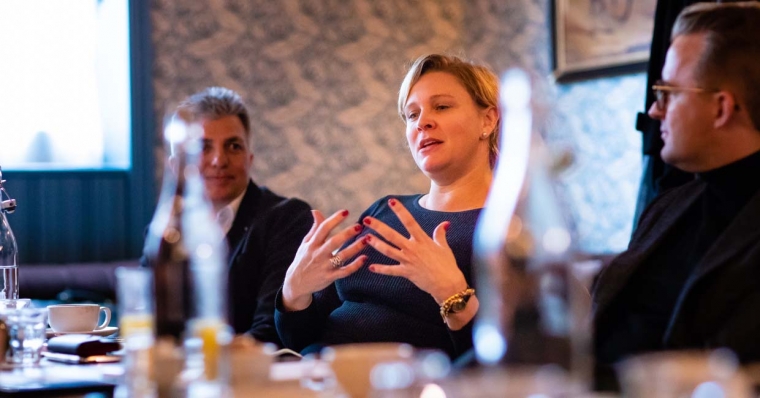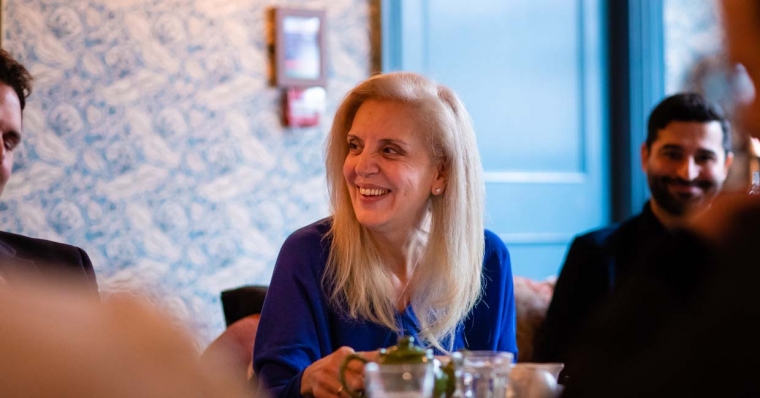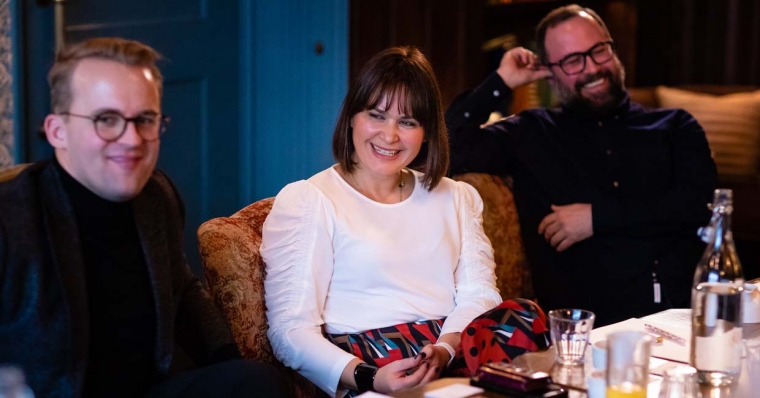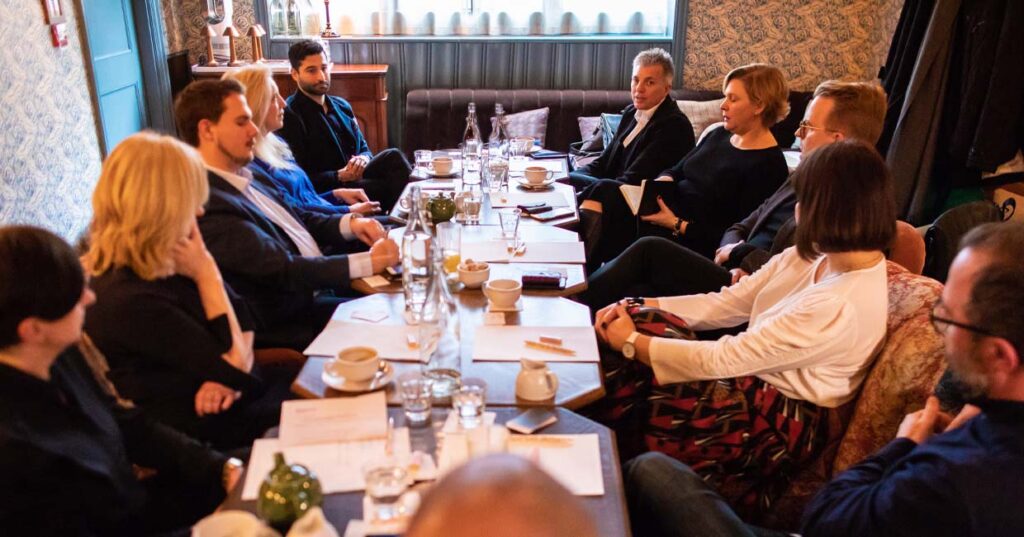Roundtable host Dernier & Hamlyn was purchased by NVC Lighting in April this year. From the company’s base in the West Midlands, NVC supplies a wide range of standard products to a variety of customers, writes Paul Farley.
Recent hospitality projects include The Gantry in London, Hampton by Hilton in Birmingham, Al Aziziyah Boutique Hotel in Doha and St Regis Polo Resort in Dubai.
The business plans to keep NVC and Dernier & Hamlyn operating in their own distinct spaces, and, alongside the bespoke products Dernier & Hamlyn has always manufactured, widen its offer to engage the premium contract decorative lighting sector.
Having the two brands operate alongside one another will enable hospitality designers to use a single source for all the lighting they require – from basic LED downlights, through functional bedroom lighting and standard decorative solutions for public areas, to custom bespoke fittings for reception areas, restaurants and bars. It also provides clients with the confidence of having a partner without many of the financial risks of working with small independent companies.
The roundtable’s venue was a private room of The Wigmore, a ‘modern British tavern’ on Regent Street. The former banking hall – which adjoins The Langham, London – was transformed by Martin Brudnizki Design Studio in 2017. Sporting classic country influences with a contemporary twist (including a spectacular 27-arm chandelier custom-made by Dernier & Hamlyn), The Wigmore’s nooks strive for a traditional residential snug feel, and proved the perfect space for this colourful roster of professionals, many of whom were already in London for Hospitality Interiors’ inaugural HLDC event.
In attendance
(Chair) Can Faik, editor, Hospitality Interiors
Alex Kravetz, principal, Alex Kravetz Design
Akram Fahmi, design director, 1508 London
Constantina Tsoutsikou, founder, Studio Lost
David Mason, director, Scott Brownrigg
Joanna Biggs, hospitality design consultant
John Paul Pederson, senior associate, Wimberly Interiors
Julie Clay, consultant, Dernier & Hamlyn
Maria Vafiadis, founder and MD, MKV Design
Monika Moser, regional MD, Wilson Associates
New directions
Can Faik kicked off proceedings by throwing open the floor to a broad, yet critical topic – which [pre-Covid-19] trends could the participants see dominating and directing hospitality design in 2020-21, and how might operators and designers respond?
“For us, it’s principally a focus on streamlining,” answered Joanna Biggs, expressing a desire for refinement and simplicity. “Providing a little less, but working really well. Combining features, offering everything you need for a five-star hotel – but without the clutter.”
Akram Fahmi considered the demand for a residential feel (the ‘home away from home’) would increasingly dictate how space was utilised, with the growth of Airbnb, the staycation and extended business trips reflecting a shift in attitudes away from the hotel’s traditional role.
There was general agreement that although location and budget are king, there’s a definite need for existing spaces to flex to meet changing demand. “For a lot of our clients, it’s about being able to adapt what you have, and designing spaces that can reflect a changing market,” commented David Mason.
Maria Vafiadis agreed. “Our lifestyle is changing,” she said, “from data collection, to how we work, to how we look after ourselves. As people, our ethos is changing – and hospitality design has to catch up.”

Danger of disconnect
Perhaps even the biggest names in hospitality risk losing touch with their customers.
“There’s a disconnect between the guest profile and what hotels provide, and what people actually want,” noted Alex Kravetz. “That’s been happening everywhere.”
Monika Moser added: “The idea that people want a home that’s better than their own, with the most cutting-edge technology and comforts – we were talking about that 20 years ago. Today, people already have these things at home, it’s all so affordable, so it’s not even a criteria anymore. Instead, you need to create an experience people are missing out on in their busy lives. And it will take some of the more old-fashioned hotels time to catch up.”
How might hospitality businesses address new demand?
“I think it’s about broadening your influences,” said David Mason. “Being a big architectural practice, we draw from all of our sectors – architecture, workplace, student housing – in our design.”
“We try to create the unexpected,” commented John Paul Pederson. “It’s about those really small touches. The big brands are having to change the way they operate and really challenge themselves, and, as designers, we face that same challenge. It’s not about a hotel being like the home, or better – it’s about the unexpected, the element of surprise. The moment where you ask yourself ‘why didn’t I think of that?'”
“The operators underestimate the guests sometimes,” added Constantina Tsoutsikou. “They have to take a little bit of a risk. For example, if they want to evoke a Bohemian escapist mood, why not mess the bed up a little bit?”
Maria Vafiadis stated that it must be a very difficult time for operators – made all the more difficult by the fact that it’s getting harder to pigeonhole customers: “The same guest that, for whatever reason, will fly Ryanair, will also fly first class on a long-haul flight, and may stay at a totally different property on those occasions. The big operators have so many brands, trying to cover every possible aspect of people’s demands – but this just mirrors how our lifestyles are evolving.”
People power
Yet, felt some, one factor continually drives a wedge between supply and demand, no matter how much variety is offered.
“In terms of service, so often the big brands just don’t think it through,” said Monika Moser. “What works in terms of lifestyle and flexibility in London might not work in Paris, where the sense of service is completely different. That’s why the operator must work with the designer to create the whole flow of a project, and convey that message to the staff – they can’t let the designer’s message get lost.”
“The staff are integral to the experience,” agreed Maria Vafiadis. “The design might not be the focus, but if it really reflects a lifestyle choice its message will be told through interactions, from beginning to end.”
“I’ve heard about projects which have seemed quite amazing at the point of completion,” reflected Constantina Tsoutsikou, “but, when the designer returns a few months later, the ambiance feels wrong. A disconnect between the restaurant and the bar, for instance. Who’s responsible if people feel uncomfortable at this stage? It can be down to how a place is run – sometimes, the staff just aren’t able to take ownership of a finished project, no matter how vibrant.”
Maria Vafiadis commented that Constantina’s story brought to mind properties that worked well precisely because of the owner/manager.
“That’s what makes the brand,” noted Alex Kravetz. “The people behind it.”
Of course, there is the very real possibility of over-servicing those guests who are simply after a quiet escape. “I travel a lot and have become very self-sufficient,” said Joanna Biggs. “Although I’ve had some great experiences, I generally find that staff get in the way. Usually they are so off message.”
Hotel training can follow strict templates, pointed out Monika Moser, thus suffocating individual agency – but there are plenty of anecdotes to the contrary, such as David Mason’s experience upon completing a project in London: “The managers worked with us throughout, and the sheer energy at launch – I’d never felt that kind of enthusiasm before.”
Sustainable sourcing
A trend with its own kind of energy that’s on every operator’s mind right now is sustainability. With ‘greener’ hospitality projects dominating the headlines, Can Faik asked the assembled experts to share their views on the importance of sustainable and ethical considerations.
John Paul Pederson led the discussion: “We are trying to get away from talking about ‘green’, and just being more conscious, training our designers to actually look around at what’s available and source more sustainably,” he said.
Alex Kravetz said he has long insisted on sourcing local materials and manpower, and has noted that this kind of “social sustainability” instils a real sense of pride in people’s work – as well as meaning a workforce can be on-site immediately.
“If you do the research and legwork, you’ll find there’s such amazing things happening locally in every country,” continued John Paul Pederson.
Designers should pay close attention to the cost of going green – particularly when it comes to recycled or reupholstered furniture – but making a considered decision is paramount, asserted Maria Vafiadis. “Sometimes, it’s a matter of really guiding the client through all the options,” she said, “as there will always be something cheaper out there.”

Social pressures
It pays to be careful, because there’s a better chance than ever that the target audience will be able to see through the cracks. Thanks to the role social media – Instagram in particular – now plays in promoting new openings, today’s projects are truly open to scrutiny. Does this trend affect how the designers present go about their work?
“One of our recent projects hinged on making a real statement in the lobby,” said Akram Fahmi. “The client wanted a ‘wow’ factor, an ‘Instagram moment’. We came up with about 50 options for the space. Some were more practical than the one you see in the finished project, but that design definitely wows!”
Seeking a hero shot is nothing new, of course. “Before Instagram, people wanted the photo that would be on the cover of Condé Nast Traveller,” noted Maria Vafiadis. “The medium is different now, but the basics are the same.”
But if everyone has a smartphone and access to social media, shouldn’t designers be creating spaces with Instagram in mind?
“Good design naturally gives you lots of good Instagram opportunities, and so much more than just a cover shot,” said Constantina Tsoutsikou, who recounts a project in which Instagrammers were enlisted prior to launch, and “got lots of great shots- they demonstrated that there are so many opportunities. The challenge is in allowing other creatives to be part of your story.”
“Good design makes the Instagram moment,” continued Akram Fahmi, “but as designers we can’t dwell on that while we’re working. We have to think about everything. There’s so much more content out there today, and you can’t control it – but you can try to be holistic in your design, and think about every moment. If it’s been properly designed, everything should be an Instagram moment.”

Bright ideas
With lighting specialist Dernier & Hamlyn hosting this roundtable, the discussion naturally veered towards the specification of bespoke lighting, how it’s affected by client requirements, and whether or not to enlist an external consultant.
“Of course, the lighting has to be right for the concept,” began Joanna Biggs. “What’s difficult is getting the client to recognise its importance.”
John Paul Pederson concurred. “Lighting can make or break a project, so lighting consultants are a big deal. We outsource ours because there’s such amazing talent out there, and the market is ever-changing.”
“It should be independent,” agreed Maria Vafiadis. “It brings such a different value.”
“Lighting consultants bring another layer of design to what we do,” added David Mason, citing a recent project in which the bar lighting pulses to varying rhythms depending on the time of day, delivering different experiences from breakfast to close.
“Of course, on any project, you have to consider other people’s visions, and flexibly,” stated Alex Kravetz, “but aesthetics remain your number-one priority – people come and go, but what’s hanging in the reception will probably stay there for longer than the rest of the interior. That’s why you have to fight for it.”
“The balance between bespoke and off-the-peg lighting purchases needs to be just right,” added Joanna Biggs, lamenting the lack of flexibility she often faces while purchasing.
According to Constantina Tsoutsikou, when it comes to lighting, workmanship is paramount. “You can see the quality,” she said, “it’s impossible to hide it. If the budget isn’t there, I’d rather take some pendants or sconces out and employ one or two special pieces instead. And because you rarely have access to all the details of the budget, it’s important that you’re present until the end of the project, just in case it needs rethinking.”
Switched on/off
The discussion ends on a subject which many feel passionately about, one way or the other – what role should in-room technology play, and why are so many businesses failing to strike a successful balance?
“I think rooms do need more tech, but it has to be easier to use,” said Joanna Biggs.
“More than that, it needs to be seamless,” added David Mason.
“From door keys to streaming, we’re doing a lot of crazy things with iPhones at the moment,” continued Monika Moser, “but sometimes owners forget the basics – you still have to pay $25 just to use the Wi-Fi in some hotels.”
Coming back to the ‘home-away-from-home’ debate, Alex Kravetz contested that, thanks to the ability to stream entertainment on smart devices, there’s very little hotel rooms need beyond that Wi-Fi connection and a simple dimmer switch. “I really get tired of technology,” he said, “and younger people will tire of it too.”
“It would be a mistake to ignore technology,” countered Maria Vafiadis. “The older generation is not so exposed to technology, but younger customers use it a lot. The problem is that the way we use technology in hotels is not balanced or done correctly.”
“You need to integrate the technology and make it simple to use,” said Akram Fahmi.
Some brands champion technology, while others avoid it completely, encouraging guests to explore the hotel’s setting instead. Could the answer be devices that are delivered to the room upon request? Or is the argument simply another example of a disconnect, and a lack of understanding of what guests want?
“Some hotels seem to be achieving that balance better than others,” noted Maria Vafiadis. “Simple controls, simple instructions, and with all the cabling installed with the flexibility to make changes as and when required.”
“You need to be able to upgrade it really fast,” agreed David Mason. “Technology can go out of date very quickly.”
Joanna Biggs mentioned voice technology, suggesting that customised Alexa-like devices could be utilised to make calls, set wake-up calls, and much more. “Wouldn’t that be cool?”
“No,” retorted Constantina Tsoutsikou. “Owners should invest in real people instead, and provide that high level of service we were talking about earlier -“
Afterthought
With the talk having overrun by quite some time, Can Faik drew proceedings to a close, thanking all present for their time, before inviting them to enjoy The Wigmore’s fresh take on quintessential British pub food, courtesy of Dernier & Hamlyn.
With so much change taking place across the industry – and the pace of that change accelerating – stopping to consider possible directions hopefully proved a fruitful exercise for all involved. The roundtable certainly reinforced that beyond the impact of technology and being mindful of the latest trends, there’s no replacing the fundamentals of good hospitality – and that designers continue to play a key role in ensuring these are realised.



